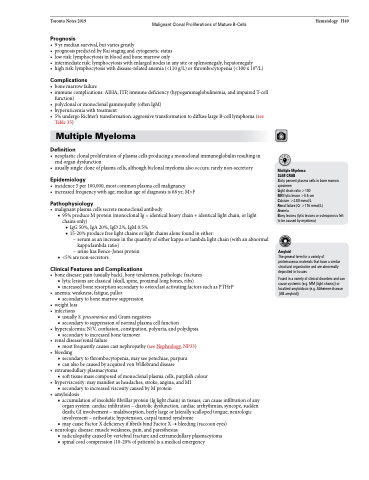Page 589 - TNFlipTest
P. 589
Toronto Notes 2019 Malignant Clonal Proliferations of Mature B-Cells
Prognosis
• 9yrmediansurvival,butvariesgreatly
• prognosispredictedbyRaistagingandcytogeneticstatus
• lowrisk:lymphocytosisinbloodandbonemarrowonly
• intermediaterisk:lymphocytosiswithenlargednodesinanysiteorsplenomegaly,hepatomegaly
• highrisk:lymphocytosiswithdisease-relatedanemia(<110g/L)orthrombocytopenia(<100x109/L)
Complications
• bonemarrowfailure
• immunecomplications:AIHA,ITP,immunedeficiency(hypogammaglobulinemia,andimpairedT-cell
function)
• polyclonalormonoclonalgammopathy(oftenIgM)
• hyperuricemiawithtreatment
• 5%undergoRichter’stransformation:aggressivetransformationtodiffuselargeB-celllymphoma(see
Table 35)
Multiple Myeloma
Definition
• neoplasticclonalproliferationofplasmacellsproducingamonoclonalimmunoglobulinresultingin end organ dysfunction
• usuallysinglecloneofplasmacells,althoughbiclonalmyelomaalsooccurs;rarelynon-secretory
Epidemiology
• incidence3per100,000,mostcommonplasmacellmalignancy
• increasedfrequencywithage;medianageofdiagnosisis68yr;M>F
Pathophysiology
• malignantplasmacellssecretemonoclonalantibody
■ 95% produce M protein (monoclonal Ig = identical heavy chain + identical light chain, or light
chains only)
◆ IgG 50%, IgA 20%, IgD 2%, IgM 0.5%
◆ 15-20% produce free light chains or light chains alone found in either:
– serum as an increase in the quantity of either kappa or lambda light chain (with an abnormal kappa:lambda ratio)
– urine has Bence-Jones protein ■ <5%arenon-secretors
Clinical Features and Complications
• bonedisease:pain(usuallyback),bonytenderness,pathologicfractures
■ lytic lesions are classical (skull, spine, proximal long bones, ribs)
■ increased bone resorption secondary to osteoclast activating factors such as PTHrP
• anemia: weakness, fatigue, pallor
■ secondary to bone marrow suppression
• weightloss • infections
■ usually S. pneumoniae and Gram-negatives
■ secondary to suppression of normal plasma cell function
• hypercalcemia:N/V,confusion,constipation,polyuria,andpolydipsia
■ secondary to increased bone turnover • renaldisease/renalfailure
■ most frequently causes cast nephropathy (see Nephrology, NP33) • bleeding
■ secondary to thrombocytopenia, may see petechiae, purpura
■ can also be caused by acquired von Willebrand disease • extramedullaryplasmacytoma
■ soft tissue mass composed of monoclonal plasma cells, purplish colour • hyperviscosity:maymanifestasheadaches,stroke,angina,andMI
■ secondarytoincreasedviscositycausedbyMprotein • amyloidosis
■ accumulation of insoluble fibrillar protein (Ig light chain) in tissues; can cause infiltration of any organ system: cardiac infiltration – diastolic dysfunction, cardiac arrhythmias, syncope, sudden death; GI involvement – malabsorption, beefy large or laterally scalloped tongue; neurologic involvement – orthostatic hypotension, carpal tunnel syndrome
■ may cause Factor X deficiency if fibrils bind Factor X → bleeding (raccoon eyes) • neurologicdisease:muscleweakness,pain,andparesthesias
■ radiculopathy caused by vertebral fracture and extramedullary plasmacytoma ■ spinal cord compression (10-20% of patients) is a medical emergency
Hematology H49
Multiple Myeloma
SLiM CRAB
Sixty percent plasma cells in bone marrow specimen
Light chain ratio >100
MRI lytic lesion >0.5 cm
Calcium >2.80 mmol/L
Renal failure (Cr >176 mmol/L)
Anemia
Bony lesions (lytic lesions or osteoporosis felt to be caused by myeloma)
Amyloid
The general term for a variety of proteinaceous materials that have a similar structural organization and are abnormally deposited in tissues
Found in a variety of clinical disorders and can cause systemic (e.g. MM [light chains]) or localized amyloidosis (e.g. Alzheimer disease
[AB amyloid])


